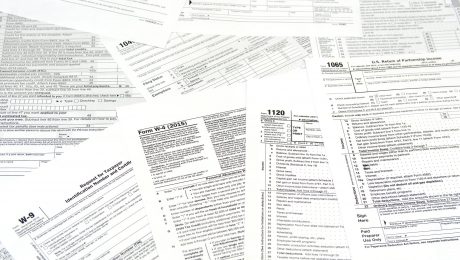How Strong is Your Business Balance Sheet?

In these very challenging and uncertain times many businesses see their sales and profitability fluctuating dramatically. They see their customers delaying purchases or reducing the size of these purchases. They may also find that their ability to get financing has diminished. It is in these times that the need for sound financial management is even more important.
When it comes to financial management, many companies focus solely on sales and profitability. This is a good start, but does not comprehend the entire picture, especially as businesses mature from an internally funded startup to externally funded business. As businesses grow in size, take on more employees, purchase fixed assets, engage in long term contracts and take on larger customers they need to be thinking not only about revenues and profits, but also assets, liabilities, equity and cash flow. They need to be thinking about how their decisions are going to impact the company’s monthly cash flow; both short term and long term. They also need to be thinking about how these same decisions will impact the company’s financial position or balance sheet. Are these decisions increasing or decreasing business risk? Are they improving financial strength or worsening it?
Runway
To borrow a term from my flight training, knowing your runway length is very important to a pilot. Pilots must know if they have adequate runway length to take-off or land their planes to ensure a successful flight. The longer the runway the more time the pilot has to implement: decisions, course corrections, emergency procedures, and survive. Applying this concept to businesses we look at a company’s monthly burn rate or expenses and compare that to how much cash or liquid assets they have in the bank. Dividing the cash by the monthly burn rate allows a business to understand how many months it can survive without sales or how long its runway is. The longer the runway or the stronger the businesses balance sheet, the more time a business has to be successful. Determining how long your runway should be will depend on your industry and your risk tolerance. It is also impacted by how quickly your company can change directions to adapt to its changing market. However, a good rule of thumb is to maintain a runway of between 12 and 24 months.

Working Capital
In many businesses, especially growing businesses, maintaining a strong balance sheet and adequate working capital is a challenge. However, with a good financial plan and sound financial controls a business can achieve a lot more success in this area. Having adequate working capital allows a business to have enough cash on hand to pay its short term liabilities such as: materials, payroll, rent and utilities. It also allows a business to continue to expand and do business with more customers and vendors. Conversely, a business that does not have a strong balance sheet and adequate working capital to pay its short term debt can find itself: cutoff by suppliers, losing employees, getting locked out of its office, just to name a few. Inadequate working capital can make it very difficult to operate on an ongoing basis.
Decision Making
Having a strong balance sheet enables a business to make decisions proactively instead of reactively. It gives the business more time to think through a decision and select an option that is in its best long term interest. Even though that decision may have a negative impact on the company’s cash position in the short term. It also allows a business to avoid unproductive time of managing dissatisfied vendors and customers that are not getting paid or paying on time.
Banks
From a banking perspective; having a strong balance sheet lowers risk. It can give the bank the assurance they need to write a business a loan, extend a line of credit, or provide it with other banking services. It also helps to ensure that the business will maintain the financial ratios required by its loan covenants. Adhering to loan covenants allows a business to remain in good standing with its lending institution and avoid having its notes or lines of credit reduced or cancelled. It also helps demonstrate to the bank that the business owner is in control of its business and has the ability to make principal and interest payments on any loan or line of credit. It also may allow the bank to provide the business with its most cost effective financing.
Survival
As most finance professionals know, “cash is king”. Having adequate cash in the bank and a long runway allows a company to sustain itself in a downturn or recession. It allows this business to be one of those left standing at the end of the day. It also allows a company to maintain its course when its competitors have to change theirs. It may allow you to: continue to market, hold on to top talent, retain key assets and avoid selling off assets at fire-sale prices. It also makes your business more attractive to those candidates seeking employment security. In many cases, having adequate cash in a downturn allows a business to potentially take advantage of its competitor’s weaknesses by: buying their business at deeply discounted prices, obtaining their customers, or buying their assets.
Not There Yet?
If you are one of those businesses that reads this letter and says, “…interesting information, but I don’t have a strong balance sheet”, then you could benefit from a plan to get you there.
It starts with research to determine what a strong balance sheet looks like for your industry.
What are those industry ratios for profitability, liquidity and solvency? What is ‘best in class’ for your industry? What will the ratios be in the future?
Use this information to establish your goals and then build a plan to get your business there over the next few years. Monitor your performance toward these goals each month to make sure you are staying on-track. Ensure that you understand the balance sheet impact of every major business decision before it is made. If you maintain focus and achieve these balance sheet goals, you will be building a stronger, more stable, more valuable business each year. You will also be building a business that is able to get the capital it needs to sustain long term growth.
Closing
Having a strong balance sheet can really make a difference with your business! It can give you the time you need to make good business decisions as well as give you the liquidity you need to operate your business on an ongoing basis. It can improve your position with your financial institution so that you get the capital you need to grow and help ensure your survival in an economic downturn. If you’re not there yet, that’s Ok, but make a plan to get there! In the end, you will have a stronger, more stable, and more valuable business!
If you have any questions regarding the financial issues discussed above or any other financial issues, please give us a call at (480) 980-3977.
Note: The information contained in this material represents a general overview of finance and should not be relied upon without an independent, professional analysis of how any of these provisions apply to a specific situation.
- Published in Newsletters
Top 5 Financial Challenges in the Transportation Industry

The transportation industry is an exciting and fast paced industry. It is a cyclical industry that is capital intensive and contains many large and small industry participants. It is a high-volume business with relatively low gross and profits margins. The industry can be significantly impacted by changes in such things as fuel prices, tariff and duties and changes in US Gross Domestic Product. This industry can present challenges from a financial perspective to its participants. Some of these challenges include: cash flow management, profit management, bad debt, financing and reporting.
1. Cash Flow Management
The transportation industry has historically been a very high-volume business with very low gross margin and profit margins. This results in very large accounts receivable and account payable balances on an ongoing basis. If customers are slow to pay their invoices (i.e. >30 days), this can quickly present challenges from a cash flow perspective. If the documentation supporting each shipment gets lost or delayed this can also delay collection. If a shipment gets damaged and there is a claim regarding the shipment, collection can be delayed. Transportation business owners need maintain aggressive accounts receivable collection processes to ensure clients receive invoices and supporting documentation quickly, clients acknowledge receipt of outstanding invoices with supporting documentation, and payments are received within payments terms. Providing invoices and receiving payments electronically is highly recommended. Maintaining a positive relationship with vendors is also critical, ensuring that vendors are paid according to payment terms is key. Matching payment terms with vendors and customers can really help to maintain positive cash flow.
2. Profit Management
The transportation industry works on very low gross margins and bottom-line profit margins. As a result, it is critical that businesses in this industry operate as efficiently as possible. This includes effectively managing capital equipment such as trucks, ensuring they are being utilized 95%+ of the time, they are well maintained and utilize the most effective routes to deliver product from origin to destination. Maintaining the optimum number of trucks will also help to keep equipment license expense at a minimum. It also includes maintain good controls over indirect spending such as: people, insurance, rent, taxes. Maintaining highly productive employees is very important. Taking the time to hire they right people for the right position is critical. Also, ensuring they are well trained, motivated, have clear expectations and that they are delivering the desired results for the company. This industry is challenged by a higher than average rate of turnover which can be costly, so taking the time to ensure you have solid employee performance management processes in place can really impact the bottom line.
Reviewing insurance coverages on a regular basis is also important. Making sure you have the right insurance for your business today and into future and working with your insurance carrier to do everything you can to reduce your risk of loss, with such things as driver education/training, asset tracking and control, solid business processes. Many businesses in this industry have significant rent expense for warehouses and land. Business owners need to ensure they are utilizing their building and land efficiently, that they do not have excessive unused building and land. This will help keep rent expense, property taxes, insurance and utility expenses at a minimum. Use of technology in the transportation industry is also very important. Businesses should be evaluating the latest technology that can be used to more efficiently and effectively transport product from origin to destination. This could be items such as: GPS technology on all trucks, load tracking/routing software, and enhanced computer technology that enables electronic transfer of information with customers and vendors.

3. Financing
The transportation industry is challenged is several areas. Many participants a small sole-proprietors that are thinly capitalized. Many of its assets (i.e. trucks) are constantly moving all over the United States. The industry has a higher than average occurrence of bad debt and theft. There is a high turnover in truck drivers. There is a high turnover in transportation businesses. All of these characteristics make it challenging for industry participants to obtain low cost working capital financing. In many cases, the financing used in this industry is factoring, factoring can be a useful financing solution in the right situation (i.e. a new rapidly growing business). However, it can be a very expensive solution when compared to tradition bank financing. For example, a traditional bank revolving line of credit may range from 5% – 7% APR while a factoring solution may range from 12% – 36% APR. This expensive financing can really take a bite out of business profits. Business owners should work to position their business over time for traditional bank financing by improving business profitability, liquidity and solvency ratios. Improving business efficiency, increasing bottom line profit strengthening the balance and driving growth will make your business more attractive to traditional lenders. It can also put the company in a good position to: weather any downturn in the economy, cyclicality in the market, or impact from changing fuel prices.
4. Bad Debt
The transportation industry is also characterized by many small sole proprietors such as truck drivers, owner operators and freight brokers. These sole proprietors can be very thinly capitalized. One or two loads that do not go as planned (i.e. damaged in shipment) can be devastating to these sole proprietors even sending them into bankruptcy or out of business. Transportation business owners need to recognize this risk and take measures to limit their exposure in this area. Some things that can be done to reduce this risk include regular credit checks on all vendors and customers, establishing tight credit limits on all vendors and customers, and aggressive collection efforts on all outstanding balances, no or limited advances to vendors. They can also consider taking security deposits from some customers who have a history of poor performance. Once the business owner has extended credit to one of these customers or vendors, they have put themselves into a challenging position. Collection and legal actions can be expensive and time consuming and even if you are successful in a getting a judgement, it still has to be collected. If the sole proprietor does not have the funds to pay or declares bankruptcy, the business owner is still not going to receive payment.
5. Reporting
Reporting and record keeping can be a challenge in the transportation industry. Especially with the large number of small owner operators and trucking companies. Many of these small owner operators and trucking companies don’t have the systems and processes in place to provide accurate, timely, electronic, information regarding their business or their shipments. This can present challenges for the transportation companies they do business with. IRS and state reporting can be delayed or inaccurate, these transportation companies can also run into problems with independent contractor reporting to the IRS.
Transportation companies that ship product across the US can also quickly find themselves subject to tax reporting in multiple states. It is critical that companies proactively manage their exposure in these areas by maintaining a good accounting system with a record of all sales by state and detailed information on customers and vendors including business name, address, tax ID and license information. These issues can be time consuming to address and result in significant fines and penalties to the transportation company.
Conclusion
The transportation industry is an exciting and fast paced industry. It is a cyclical industry that is capital intensive and contains many large and small industry participants. It is a high-volume business with relatively tight gross margin and profits margins. The industry can be significantly impacted by changes in such things as fuel prices, tariff and duties and changes in US Gross Domestic Product. This industry can present challenges from a financial perspective to its participants. Some of these challenges include: cash flow management, profit management, bad debt, financing, reporting. Business owners that are able to effectively manage these challenges can really improve their bottom line!
If you have any questions regarding the financial issues discussed above or any other financial issues, please give us a call at (480) 980-3977.
Note: The information contained in this material represents a general overview of finance and should not be relied upon without an independent, professional analysis of how any of these provisions apply to a specific situation.
- Published in Newsletters
How to Position Your Company for Growth in a Recession

Necessity may be the mother of invention but, could a recession be the mother of innovation? If we take a look at history we can make a strong case for just that! More than half of the 2009 Fortune 500 Companies were founded in a recession. Many of the world’s leading, multibillion-dollar corporations, from General Electric to Microsoft, were founded during economic downturns. Hewlett Packard, Fedex, CNN, Fortune Magazine, Revlon Cosmetics, Hyatt, Burger King, and Cliff Bar were all founded during recessions. In general, operating costs tend to be cheaper in a recession. Talent is easier to find because of widespread layoffs. Competition is usually less fierce because, honestly, many players are taken out of the game.
According to a study conducted by the Ewing Marion Kauffman Foundation, “challenging economic times often serve as the rebirth of entrepreneurial capitalism, leading to the creation of much-needed new jobs.” Recessions can also help executives figure out how to improve products, services, and processes internally and for customers. Ideally, the creative thinking that’s needed to weather the storm of an economic downturn can lead to new markets and revenue streams. Innovation originates from challenges.
Here are 5 tips you may want to consider to position your company for growth in a recession:
#1. Leverage Your Strengths
In this market, it is important to focus on your core competencies. What do you do best or better than your competition? Stay focused on these key areas by continuing to measure your performance in these areas on a regular basis. Communicate regularly with your top customers and keep your staff focused on exceeding your customer’s expectations. These customers will be the customers that sustain you through this recession. Continue to market and drive additional sales in your target market. You need to continue to fill the pipeline with new customers as some of your existing customers just won’t survive recession.
#2. Streamline Your Operations
In addition, to staying focused, it is important to understand the key drivers of your business and improve them. Embrace the idea of continuous improvement. How can you get more output out of the same resources? Review each of these key drivers in more detail and explore creative ways for improving them. Challenge your staff to evaluate their areas and come up with ideas for doing things better, faster or cheaper. Some examples of this may include evaluating new and faster ways for getting and closing sales. How could we get more sales with the same human and capital resources? Is there an opportunity to utilize technology to generate sales more quickly? Is there a way to close deals and ship product faster?
#3. Maintain Cash Flow
Understand your businesses cash flow picture. Is your cash position improving or deteriorating? Look for ways to improve your cash flow position. Some examples of this might include making your expenses variable where possible, so that you incur expenses only when you generate revenue. Other ways may include matching your cash inflows with your cash outflows, by minimizing inventory positions, aligning credit terms with customers and suppliers. Keep a close eye on the credit you extend to customers, especially if the customer’s financial position is weak or weakening. Require payment upfront for new customers and only consider providing credit to those customers that have a solid track record of paying their bills on-time.
You can also improve cash flow by increasing turnover. Increasing accounts receivable turnover or how quickly you collect your sales as well as how quickly you turnover your inventory can really make a difference to your cash flow. The faster you turn your sales and inventory into cash the better your cash flow. Higher turnover also helps to reduce your risk of bad debt and inventory obsolescence. The more you can build up your cash reserves, the longer you will be able to sustain your company in a protracted recession and have the cash you need to take advantage of market opportunities.
#4. Position Yourself to Take Advantage of Market Opportunities
Recessions can create opportunities for those businesses with the financial strength and vision to move quickly. Keep an eye on your competition, understand who is doing well and who is struggling to stay afloat. Understand who is servicing their customer well and who is not. If you position yourself correctly, you may be able to take advantage of some of these changes in your market. You may be able to buy all or a portion of your competitors at deeply discounted prices. You may be able to pursue some of those unsatisfied customer. You may also be able to pick up some of their top talent to round out your own team and position you for growth as the market rebounds. Recognize that these types of markets foster creative thinking, so be open to opportunities to partner with suppliers, customers and even competitors to create new business models.

#5. Communicate
It’s important is these market to stay positive and communicate. Communicate with your staff, so they know where the company is headed and can help you identify those next big opportunities. Encourage innovation among your staff, let them know that you value their opinion. Reward good ideas. Communicate with your financial resources, so they understand your position and your plan to be successful. Let your financial partners know that you have their interests in mind and need their support to be successful. The more you communicate with your financial partners, the more they will understand your business and your market, and the more they will be willing to work with you if things don’t go exactly as planned.
Conclusion
Recession could be the mother of innovation. So stay focused on what you do best, look for ways to streamline your operations, keep a close eye on your cash flow, put yourself in a good position in your market and communicate. It could really make a difference in your bottom line.
Note: The information contained in this material represents a general overview of accounting and should not be relied upon without an independent, professional analysis of how any of these provisions apply to a specific situation.
- Published in Newsletters
Measuring Business Financial Strength

Business financial strength is of vital concern to business owners, corporate managers, investors and lenders. Efficiency and cost control are keys to success in many companies throughout the United States and the world. There are many ways to measure the financial strength of a company. The key is identifying the right measurement tools for the company, taking into consideration: the industry, stage of life cycle, time horizon, business objectives, and economic conditions. It is also important to understand your company’s financial performance relative to its industry as all companies compete in the marketplace on a local, regional, national or international level. In general, the financial strength of a company can be measured in three key areas: profitability, liquidity and solvency.
Profitability
Profitability measures a company’s ability to generate profit or positive net income for a given level of sales or investment. If a company is not profitable it eventually becomes insolvent and may require reorganization or liquidation. The greater a company’s ratio of net income to sales or investment, the stronger it is. One example of a financial ratio that measures a firm’s profitability is the profit margin ratio which measures the amount of net income a company generates relative to the amount of sales it generates. Another example of a financial ratio that measures profitability is return on investment or ‘ROI’ which measures a firm’s profitability relative to the amount of capital invested to generate that profitability.
Liquidity
Liquidity measures a company’s ability to utilize its resources available to meet its short term commitments. If a company cannot meet its short term commitments on time, it eventually becomes insolvent and may require reorganization or liquidation. The greater the ratio of resources available to short term commitments, the stronger the company. One example of a financial ratio that measures liquidity is the current ratio. The current ratio measures the size of a company’s current assets (i.e. assets that can be converted into cash in less than 12 months) to the size of its current liabilities (debts that have to be paid in less than 12 months). Other liquidity ratios measure the company’s working capital required for the level of sales generated. One example of a financial ratio that measures this characteristic is the accounts receivable turnover ratio, which measures the size of sales relative to the size of average accounts receivable.

Solvency
Solvency measures a company’s ability to meet its interest and principal payments on long term debt and similar obligations as they come due. If a company cannot make payments on time, it becomes insolvent and may require reorganization or liquidation. One example of a financial ratio which measures a firm’s long term solvency is the debt ratio. This ratio measures the amount of long term debt financing as a proportion of its overall capital structure. In this case the greater the ratio of long term debt to overall capital the great the solvency risk and the weaker the company.
Key Drivers of Your Business
As we mentioned above, there are many ways to measure the financial strength of a company. The financial metrics mentioned above are a few of the key metrics used to measure performance. The key is to identify the right metrics for your business. One way to identify these metrics is to identify the key drivers of your business and then identify those financial metrics that will help you track these key drivers. For example, in one industry one of the key drivers may be sales growth and profitability, while for another industry the key drivers might be cost control and liquidity. The former may want to utilize more profitability metrics to track performance, while the latter may want to utilize more liquidity metrics to track performance.

Keep It In Context
It’s important to measure financial performance in some context. Understand how your financial performance compares to your industry average and best in class. Are you doing better or worse you’re your competition? Understand how your financial performance compares to historical trends. Is your company gaining financial strength or losing financial strength over time? Understand how your financial performance compares to your long range plan. Is your company on-track to achieving its long term financial goals or do you need to make some course corrections to get back on track? By making these comparisons you will clearly understand how your company is performing in the marketplace. You will also be better able to identify those changes you need to make to be successful.
In addition to increased profitability, liquidity and solvency, companies that put programs in place to aggressively measure and improve financial strength can benefit tremendously. These benefits can include greater access to debt and equity capital, lower cost of capital, increased growth, increased market share, increased flexibility and ability to respond faster to changes in the market.
Conclusion
Business owners can no longer afford to manage by gut feel. Business owners need to monitor the financial strength of their companies relative to their marketplace on an ongoing basis. Placing increased focus on the key areas of business profitability, liquidity and solvency can really have a positive impact on your financial strength and bottom line!
Note: The information contained in this material represents a general overview of accounting and should not be relied upon without an independent, professional analysis of how any of these provisions apply to a specific situation.
- Published in Newsletters
Qualified Opportunity Zones

President Trump signed the Tax Cuts and Jobs Act (“TCJA”) on December 22, 2017. This $1.4 trillion tax cut was expected to lower taxes for middle-class Americans and bring back jobs to the United States. One of the new provisions in this act was the creation of “Qualified Opportunity Zones” under Internal Revenue Code 1400Z-1 and 1400Z-2. These Qualified Opportunity Zone provisions could provide businesses, projects, and commercial property in eligible low-income census tracts, attractive financing for economic development. They could also provide opportunities for investors, individuals and corporations, to defer tax on current capital gains, significantly increase tax basis in their current investments, and abate all future tax on capital gains from these investments.
A “Qualified Opportunity Zone” is a population census tract that is a low-income community that is designated as a qualified opportunity zone. The governor of each state and the US Treasury Department certify the qualified opportunity zones within a state. In Arizona, portions of: Phoenix, Scottsdale, Glendale, Tempe and Mesa have been designated as Opportunity Zones.
This new tax provision provides an effective deferral mechanism for short and long-term capital gains from current investments in nearly all asset classes including stocks and other securities. Unlike Section 1031 “like-kind” deferral, qualified opportunity zones will provide: (i) the ability to invest only the gain rather than the entire current investment, (ii) a broader range of investments eligible for the deferral, (iii) a potential basis step-up of 15 percent of the initial deferred amount of investment, and (iv) an opportunity to abate all taxation on capital gains post-investment.
The new provision allows taxpayers to defer the short term or long-term capital gains tax due upon a sale or disposition of property if the capital gain portion of the sale or disposition is reinvested within 180 days in a “qualified opportunity fund.” A “Qualified Opportunity Zone Fund” is a corporation or partnership that invests at least 90 percent of its assets in qualified opportunity zone property.

If the investment is maintained in the “qualified opportunity fund” for five years, the taxpayer will receive a step-up in tax basis equal to 10 percent of the original gain. If the investment is maintained in the “qualified opportunity fund” for seven years, the taxpayer will receive an additional five percent step-up in tax basis. A recognition event will occur on Dec. 31, 2026, in the amount of the lesser of (i) the remaining deferred gain or (ii) the fair market value of the investment in the “qualified opportunity fund.” Investments maintained for 10 years and until at least Dec. 31, 2026, will allow for an exclusion of all capital gains, from post-acquisition gain on the investment in a “qualified opportunity fund”, to be excluded from gross income. For an investment maintained longer than 10 years and upon a sale or disposition of the investment, the new provision also allows the taxpayer to elect the basis in the investment to be equal to the fair market value of the investment.
Example
John Taxpayer bought stock in XYZ Corporation in 2010 for $20,000, and today it is worth $40,000. John thinks XYZ Corporation stock has topped out and he wants to sell; selling will cause John to realize $20,000 in capital gain. Before Opportunity Funds, there were only two choices: (1) continue to hold the stock and defer the gain/tax, or (2) sell and pay over $4,000 in income tax. Now there is a third choice – the Opportunity Fund. If John sells his XYZ Corporation stock for $40,000, and reinvests the $20,000 gain in an Opportunity Fund, he gets to keep his original investment of $20,000 and pay no taxes*. If John leaves his $20,000 in the Opportunity Fund for 10 years and it increases in value to $40,000, he gets the post-acquisition gain of $20,000 in year 10 entirely tax free.
*The deferral of tax on John’s initial $20,000 gain is good until 2026 and then the gain must be recognized, but with certain advantages explained in detail below.
John receives three benefits from his Opportunity Fund Investment:
1) Capital Gains Tax Deferral until 2026 – Because he rolls his initial gain into an Opportunity Fund, John does not pay tax on the $20,000 gain today. He does pay the tax in 2026, but in the meantime his $20,000 gain has been invested and is earning a return.
2) Basis Step up of 15% – Not only does John keep his $20,000 gain invested and earning a return for 8 years, the gain that John pays tax on in 2026 is reduced by 15%. Rather than paying tax on $20,000 of gain on his XYZ Corporation stock, he will pay tax on only $17,000.
3) 100% Capital Gains Exclusion – If John leaves his $20,000 invested in the Opportunity Fund for 10 years, his gain on the $20,000 is tax free. In our example, if John’s Opportunity Fund investment appreciates at 7% per year, then in year 10 John would receive back his $20,000 initial investment, plus an additional $20,000 in tax-free capital gains.
While Qualified Opportunity Zone Funds appear to offer some significant tax advantages, they are still very new. Although the US treasury and IRS are charged with monitoring the program, their oversight mechanisms aren’t fully set up yet. That means that anyone could create a fund and solicit investors. There’s no guarantee that the projects will fit within the Qualified Opportunity Zone requirements or that the project will be successful. As always, you must perform your due diligence to make certain that you understand how the program works and whether your investment meets the Qualified Opportunity Zone requirements.
One of the new provisions in the JCJA was the creation of “Qualified Opportunity Zones.” under Internal Revenue Code 1400Z-1 and 1400Z-2. These Qualified Opportunity Zone provisions could provide businesses, projects, and commercial property in eligible low-income census tracts attractive financing and what could amount to a substantial long-term subsidy for economic development. They could also provide opportunities for investors, individuals and corporations, to defer tax on current capital gains, significantly increase basis in their current investments, and abate all future tax on capital gains from these investments.
Please let us know if you have questions concerning Qualified Opportunity Zones or any other tax compliance or planning issues. Call us today (480) 980-3977.
Paul J. Beckert MBA, CPA
Note: The information contained in this material represents a general overview of tax and should not be relied upon without an independent, professional analysis of how any of these provisions apply to a specific situation.
- Published in Newsletters
Individual Tax Engagement Letter
Pinnacle Business Solutions L.L.P.
Individual Tax Engagement Letter
2018
CLIENT NAME:
STREET ADDRESS:
CITY, STATE ZIP:
Subject: Preparation of Your Individual Tax Returns
Dear CLIENT NAME:
Thank you for selecting Pinnacle Business Solutions to assist you with your tax affairs. This letter confirms the terms of our engagement with you and the nature and extent of services we will provide.
We will prepare the 2018 federal and all state income tax returns you request using information you provide to us. We may ask for clarification of some items, but we will not audit or otherwise verify the data you submit. We’ve enclosed an “Organizer” to help you gather the information required for a complete return. If you use the Organizer, it will help you avoid overlooking important information and contribute to efficient preparation of your returns. That helps keep the cost of our services as low as possible.
It is your responsibility to provide information required for preparation of complete and accurate returns. You should keep all documents, canceled checks and other data that support your reported income and deductions. They may be necessary to prove accuracy and completeness of the returns to a taxing authority. You are responsible for the returns, so you should review them carefully before you sign them.
Unless we are otherwise advised, you are responsible for confirming that personal expenses, if any, are segregated from business expenses and expenses such as meals, travel, entertainment, vehicle use, gifts, and related expenses, are supported by necessary records required by the IRS and other taxing authorities. At your request, we are available to answer your questions and advise you on the types of supporting records required.
You are responsible for determining your state or local tax filing obligations with any state or local tax authorities, including, but not limited to, income, franchise, sales, use, or property taxes. You agree that we have no responsibility to research these obligations or to inform you of them. If upon review of the information you have provided us and other information that comes to our attention, we believe you may have an obligation to file additional tax returns, we will notify you of this in writing and ask you to contact us. If you ask us to prepare these returns, we will confirm this in a separate engagement letter and delineate the additional charges for this service.
We will prepare the above referenced tax returns solely for filing with the Internal Revenue Service (“IRS”) and state and local tax authorities as identified above. Our work is not intended to benefit or influence any third party, either to obtain credit or for any other purpose.
You agree to indemnify and hold our firm and its partners, principals, shareholders, officers, directors, members, employees, agents or assigns (collectively, “firm,” “we,” “us,” or “our”) harmless with respect to any and all claims arising from the use of the tax returns for any purpose other than filing with the IRS and state and local tax authorities regardless of the nature of the claim, including the negligence of any party.
Our work will not include any procedures to discover defalcations or other irregularities. The only accounting or analysis work we will do is that which is necessary for preparation of your income tax returns.
We will use our judgment to resolve questions in your favor where a tax law is unclear assuming there is reasonable justification for doing so. Whenever we are aware that an applicable tax law is unclear or there are conflicting interpretations of the law by authorities, we will explain the possible positions that may be taken on your return. We will follow the position you request, provided it is consistent with our understanding of the current tax code, laws, regulations and their interpretations. If the IRS or state tax authorities later contest the position taken, there may be an assessment of additional tax, interest, and penalties. We assume no liability for and you hereby release us from any such additional tax, interest, and penalties or other fees and assessments.
Penalties of as much as $100,000 can be imposed on you for failing to disclose participation in “reportable transactions,” that is, certain arrangement the IRS has identified as potentially abusive. We will insist that all such transactions be properly disclosed. See Appendix A for a schedule of listed transactions.
The IRS and many states impose penalties for substantial understatement of tax. To avoid the substantial understatement penalty, you must have substantial authority to support the tax treatment of the item challenged by the IRS or adequate disclosure of the item. A completed IRS Form 8275 or 8275-R, which discloses all relevant facts, may be required to be attached to your tax return to meet the adequate disclosure requirement. A disclosed tax position that meets the reasonable basis standard must have some authority supporting the position and be more than just arguable.
Your returns may be selected for audit by a taxing authority. Any proposed adjustments are subject to appeal. In the event of a tax examination, we can arrange to be available to represent you. Such representation will be a separate engagement for which an engagement letter will be provided to you. Fees and expenses for defending the returns will be invoiced in accordance with terms we agree on for that engagement.
We require an advance payment of 50% of our estimated fee before beginning our work. Please submit your payment with your trial balance and other supporting data. We will contact you via the e-mail address you provide (or mailing address, if no valid e-mail address is provided) to advise you when the returns are completed and available for filing. You agree that the advance payment is fully earned as of the date we provide you with this notice. Payment of the remaining balance will be due within 7 business days of the date of our e-mail or letter. Once we have verified receipt of your valid payment, we will either provide you with the completed returns for filing or file the returns electronically on your behalf.
Our professional fee for the services outlined above will be estimated at $xxx. This fee is based upon the complexity of the work to be performed and our professional time to complete the work. Additionally, this fee depends upon the availability, quality, and completeness of your records. You agree that you will deliver all records requested by our staff to complete this engagement on a timely basis.
In the event your records are not submitted in a timely manner, or are incomplete or unusable, we reserve the right to charge additional fees and expenses for services required to correct the problem. If this occurs, we will contact you to discuss the matter and the anticipated delay in completing our engagement prior to rendering further services.
We will be offering a new service this year at no additional charge to you, it is called “Intuit Link”. Intuit Link will allow you to more efficiently communicate with us via the Intuit Link portal. This easy to use portal is used to securely transfer documents and information between your company and Pinnacle Business Solutions. Intuit Link can also be used to provide periodic reminders to Pinnacle Business Solutions and its clients to ensure that the necessary information is submitted to Pinnacle Business Solutions and that your income tax filing is submitted on time. This service will be optional for all clients. You will be able to choose whether or not you want to utilize this new service.
We will also be offering the Intuit eSignature service this year. This service will allow for the more efficient signature of all legal documents needed prepare and file your tax return. This service will be optional for all clients. You will be able to choose whether or not you want to utilize this service. The additional charge for this service will be $5 per eSignature.
Another new service we will be offering this year is Intuit Pay-By-Refund which is offered through our partner Refund Advantage. This service will allow you to pay your tax preparation fees out of your federal tax refund. This service will be optional for all clients. You will be able to choose whether or not you want to utilize this new service. The fee to utilize this service will be $50/return.
We will bill you for our professional fees, expenses and out-of-pocket costs as of the date we deliver our work product you. Payment is due upon receipt of the billing statement. If payment is not received by the due date, you will be assessed interest charges of 2.33 % per month on the unpaid balance.
You agree that in the event your payment of tax is not received by the due date of the tax return, we will not be responsible for your failure to meet government and other filing deadlines, for any penalties or interest that may be assessed against you resulting from your failure to meet the deadlines, and for any other damages (including, but not limited to consequential, indirect, lost profits, or punitive damages) incurred by you as a result of the late filing or non-filing of the tax returns.
We will retain copies of records you supplied to us along with our work papers for your engagement for a period of seven years. After seven years, our work papers and engagement files will be destroyed. All of your original records will be returned to you at the end of this engagement. You should keep the original records in secure storage.
To affirm that this letter correctly summarizes your understanding of the arrangements for this work, please sign the enclosed copy of this letter in the space indicated and return it to us at the address below.
We appreciate your business. Please call if you have questions.
Sincerely,
_____________________________________________________
Paul J. Beckert, President, Pinnacle Business Solutions L.L.P.
Accepted By: _________________________________________
_________________________________________
Date: ________________________________________________
Appendix A
Listed Transactions
- Revenue Ruling 90-105 – Certain Accelerated Deductions for Contributions to a Qualified Cash or Deferred Arrangement or Matching Contributions to a Defined Contribution Plan
- Notice 95-34 – Voluntary Employee Beneficiary Association
- ASA Investering Partnership v. Commissioner -Transactions similar to that described in the ASA Investering litigation and in ACM Partnership v. Commissioner
- Treasury Regulation § 1.643(a)-8 – Certain Distributions from Charitable Remainder Trusts
- Notice 99-59 – Corporate Distributions of Encumbered Property (BOSS)
- Step-Down Step Down Preferred/Fast Pay Stock §1.7701(1)-3
- Revenue Ruling 2000-12 – Debt Straddles
- Notice 2000-44 – Inflated Partnership Basis Transactions (Son of Boss)
- Notice 2000-60 Stock Compensation Stock Compensation Transactions
- Notice 2000-61 – Guam Trust
- Notice 2001-16 – Intermediary Transactions
- Notice 2001-17 – §351 Contingent Liability
- Notice 2001- 45 – §302 Basis-Shifting Transactions
- Notice 2002-21 – Inflated Basis “CARDS” Transactions
- Notice 2002-35 – Notional Principal Contracts
- Common Trust Fund Straddles (Notice 2003-54), Pass-Through Entity Straddle (Notice 2002-50), and S Corporation Tax Shelter Transaction (Notice 2002-65)
- Revenue Ruling 2002-69 – Lease In / Lease Out or LILO Transactions
- Revenue Ruling 2003-6 – Abuses Associated with S Corp ESOPs
- Notice 2003-22 – Offshore Deferred Compensation Arrangements
- Notice 2003-24 – Certain Trust Arrangements Seeking to Qualify for Exception for Collectively Bargained Welfare Benefit Funds under § 419A(f)(5)
- Notice 2003-47 – Transfers of Compensatory Stock Options to Related Persons
- Notice 2003-55 – Accounting for Lease Strips and Other Stripping Transactions
- Notice 2003-77 – Improper use of contested liability trusts to attempt to accelerate deductions for contested liabilities under IRC 461(f)
- Notice 2003-81 – Major/Minor Tax Avoidance Using Offsetting Foreign currency Option Contracts
- Notice 2004-8 – Abusive Roth IRA Transactions
- Revenue Ruling 2004-4 – S Corporations ESOP
- Revenue Ruling 2004-20 – Abusive Transactions Involving Insurance Policies in IRC 412(i) Retirement Plans
- Notice 2004-20 – Abusive Foreign Tax Credit Transactions
- Notice 2004-30 – S Corporation Tax Shelter Involving Shifting Income to Tax Exempt Organization
- Notice 2004-31 – Intercompany Financing Through Partnerships
- Notice 2005-13 – Sale-In Lease-Out transactions
- Notice 2007-57 – Loss Importation Transaction
- Notice 2007-83 – Abusive Trust Arrangements Utilizing Cash Value Life Insurance Policies Purportedly to Provide Welfare Benefits
- Notice 2008-34 – Distressed Asset Trust (DAT) Transaction
- Published in Newsletters
Business Tax Engagement Letter
Pinnacle Business Solutions L.L.P.
Business Tax Engagement Letter
2018
CLIENT NAME:
STREET ADDRESS:
CITY, STATE ZIP:
Subject: Preparation of Your Business Tax Returns
Dear CLIENT NAME:
Thank you for selecting Pinnacle Business Solutions to assist you with your tax affairs. This letter confirms the terms of our engagement with you and the nature and extent of services we will provide.
We will prepare the 2018 federal and all state income tax returns you request using information you provide to us. We may ask for clarification of some items, but we will not audit or otherwise verify the data you submit. We’ve enclosed an “Organizer” to help you gather the information required for a complete return. If you use the Organizer, it will help you avoid overlooking important information and contribute to efficient preparation of your returns. That helps keep the cost of our services as low as possible.
It is your responsibility to provide information required for preparation of complete and accurate returns. You should keep all documents, canceled checks and other data that support your reported income and deductions. They may be necessary to prove accuracy and completeness of the returns to a taxing authority. You are responsible for the returns, so you should review them carefully before you sign them.
Unless we are otherwise advised, you are responsible for confirming that personal expenses, if any, are segregated from business expenses and expenses such as meals, travel, entertainment, vehicle use, gifts, and related expenses, are supported by necessary records required by the IRS and other taxing authorities. At your request, we are available to answer your questions and advise you on the types of supporting records required.
You are responsible for determining your state or local tax filing obligations with any state or local tax authorities, including, but not limited to, income, franchise, sales, use, or property taxes. You agree that we have no responsibility to research these obligations or to inform you of them. If upon review of the information you have provided us and other information that comes to our attention, we believe you may have an obligation to file additional tax returns, we will notify you of this in writing and ask you to contact us. If you ask us to prepare these returns, we will confirm this in a separate engagement letter and delineate the additional charges for this service.
We will prepare the above referenced tax returns solely for filing with the Internal Revenue Service (“IRS”) and state and local tax authorities as identified above. Our work is not intended to benefit or influence any third party, either to obtain credit or for any other purpose.
You agree to indemnify and hold our firm and its partners, principals, shareholders, officers, directors, members, employees, agents or assigns (collectively, “firm,” “we,” “us,” or “our”) harmless with respect to any and all claims arising from the use of the tax returns for any purpose other than filing with the IRS and state and local tax authorities regardless of the nature of the claim, including the negligence of any party.
Our work will not include any procedures to discover defalcations or other irregularities. The only accounting or analysis work we will do is that which is necessary for preparation of your income tax returns.
We will use our judgment to resolve questions in your favor where a tax law is unclear assuming there is reasonable justification for doing so. Whenever we are aware that an applicable tax law is unclear or there are conflicting interpretations of the law by authorities, we will explain the possible positions that may be taken on your return. We will follow the position you request, provided it is consistent with our understanding of the current tax code, laws, regulations and their interpretations. If the IRS or state tax authorities later contest the position taken, there may be an assessment of additional tax, interest, and penalties. We assume no liability for and you hereby release us from any such additional tax, interest, and penalties or other fees and assessments.
Penalties of as much as $100,000 can be imposed on you for failing to disclose participation in “reportable transactions,” that is, certain arrangement the IRS has identified as potentially abusive. We will insist that all such transactions be properly disclosed. See Appendix A for a schedule of listed transactions.
The IRS and many states impose penalties for substantial understatement of tax. To avoid the substantial understatement penalty, you must have substantial authority to support the tax treatment of the item challenged by the IRS or adequate disclosure of the item. A completed IRS Form 8275 or 8275-R, which discloses all relevant facts, may be required to be attached to your tax return to meet the adequate disclosure requirement. A disclosed tax position that meets the reasonable basis standard must have some authority supporting the position and be more than just arguable.
Your returns may be selected for audit by a taxing authority. Any proposed adjustments are subject to appeal. In the event of a tax examination, we can arrange to be available to represent you. Such representation will be a separate engagement for which an engagement letter will be provided to you. Fees and expenses for defending the returns will be invoiced in accordance with terms we agree on for that engagement.
We require an advance payment of 50% of our estimated fee before beginning our work. Please submit your payment with your trial balance and other supporting data. We will contact you via the e-mail address you provide (or mailing address, if no valid e-mail address is provided) to advise you when the returns are completed and available for filing. You agree that the advance payment is fully earned as of the date we provide you with this notice. Payment of the remaining balance will be due within 7 business days of the date of our e-mail or letter. Once we have verified receipt of your valid payment, we will either provide you with the completed returns for filing or file the returns electronically on your behalf.
Our professional fee for the services outlined above will be estimated at $xxx. This fee is based upon the complexity of the work to be performed and our professional time to complete the work. Additionally, this fee depends upon the availability, quality, and completeness of your records. You agree that you will deliver all records requested by our staff to complete this engagement on a timely basis.
In the event your records are not submitted in a timely manner, or are incomplete or unusable, we reserve the right to charge additional fees and expenses for services required to correct the problem. If this occurs, we will contact you to discuss the matter and the anticipated delay in completing our engagement prior to rendering further services.
We will be offering a new service this year at no additional charge to you, it is called “Intuit Link”. Intuit Link will allow you to more efficiently communicate with us via the Intuit Link portal. This easy to use portal is used to securely transfer documents and information between your company and Pinnacle Business Solutions. Intuit Link can also be used to provide periodic reminders to Pinnacle Business Solutions and its clients to ensure that the necessary information is submitted to Pinnacle Business Solutions and that your income tax filing is submitted on time. This service will be optional for all clients. You will be able to choose whether or not you want to utilize this new service.
We will also be offering the Intuit eSignature service this year. This service will allow for the more efficient signature of all legal documents needed prepare and file your tax return. This service will be optional for all clients. You will be able to choose whether or not you want to utilize this service. The additional charge for this service will be $5 per eSignature.
Another new service we will be offering this year is Intuit Pay-By-Refund which is offered through our partner Refund Advantage. This service will allow you to pay your tax preparation fees out of your federal tax refund. This service will be optional for all clients. You will be able to choose whether or not you want to utilize this new service. The fee to utilize this service will be $50/return.
We will bill you for our professional fees, expenses and out-of-pocket costs as of the date we deliver our work product you. Payment is due upon receipt of the billing statement. If payment is not received by the due date, you will be assessed interest charges of 2.33 % per month on the unpaid balance.
You agree that in the event your payment of tax is not received by the due date of the tax return, we will not be responsible for your failure to meet government and other filing deadlines, for any penalties or interest that may be assessed against you resulting from your failure to meet the deadlines, and for any other damages (including, but not limited to consequential, indirect, lost profits, or punitive damages) incurred by you as a result of the late filing or non-filing of the tax returns.
We will retain copies of records you supplied to us along with our work papers for your engagement for a period of seven years. After seven years, our work papers and engagement files will be destroyed. All of your original records will be returned to you at the end of this engagement. You should keep the original records in secure storage.
To affirm that this letter correctly summarizes your understanding of the arrangements for this work, please sign the enclosed copy of this letter in the space indicated and return it to us at the address below.
We appreciate your business. Please call if you have questions.
Sincerely,
_____________________________________________________
Paul J. Beckert, President, Pinnacle Business Solutions L.L.P.
Accepted By: _________________________________________
_________________________________________
Date: ________________________________________________
Appendix A
Listed Transactions
- Revenue Ruling 90-105 – Certain Accelerated Deductions for Contributions to a Qualified Cash or Deferred Arrangement or Matching Contributions to a Defined Contribution Plan
- Notice 95-34 – Voluntary Employee Beneficiary Association
- ASA Investering Partnership v. Commissioner -Transactions similar to that described in the ASA Investering litigation and in ACM Partnership v. Commissioner
- Treasury Regulation § 1.643(a)-8 – Certain Distributions from Charitable Remainder Trusts
- Notice 99-59 – Corporate Distributions of Encumbered Property (BOSS)
- Step-Down Step Down Preferred/Fast Pay Stock §1.7701(1)-3
- Revenue Ruling 2000-12 – Debt Straddles
- Notice 2000-44 – Inflated Partnership Basis Transactions (Son of Boss)
- Notice 2000-60 Stock Compensation Stock Compensation Transactions
- Notice 2000-61 – Guam Trust
- Notice 2001-16 – Intermediary Transactions
- Notice 2001-17 – §351 Contingent Liability
- Notice 2001- 45 – §302 Basis-Shifting Transactions
- Notice 2002-21 – Inflated Basis “CARDS” Transactions
- Notice 2002-35 – Notional Principal Contracts
- Common Trust Fund Straddles (Notice 2003-54), Pass-Through Entity Straddle (Notice 2002-50), and S Corporation Tax Shelter Transaction (Notice 2002-65)
- Revenue Ruling 2002-69 – Lease In / Lease Out or LILO Transactions
- Revenue Ruling 2003-6 – Abuses Associated with S Corp ESOPs
- Notice 2003-22 – Offshore Deferred Compensation Arrangements
- Notice 2003-24 – Certain Trust Arrangements Seeking to Qualify for Exception for Collectively Bargained Welfare Benefit Funds under § 419A(f)(5)
- Notice 2003-47 – Transfers of Compensatory Stock Options to Related Persons
- Notice 2003-55 – Accounting for Lease Strips and Other Stripping Transactions
- Notice 2003-77 – Improper use of contested liability trusts to attempt to accelerate deductions for contested liabilities under IRC 461(f)
- Notice 2003-81 – Major/Minor Tax Avoidance Using Offsetting Foreign currency Option Contracts
- Notice 2004-8 – Abusive Roth IRA Transactions
- Revenue Ruling 2004-4 – S Corporations ESOP
- Revenue Ruling 2004-20 – Abusive Transactions Involving Insurance Policies in IRC 412(i) Retirement Plans
- Notice 2004-20 – Abusive Foreign Tax Credit Transactions
- Notice 2004-30 – S Corporation Tax Shelter Involving Shifting Income to Tax Exempt Organization
- Notice 2004-31 – Intercompany Financing Through Partnerships
- Notice 2005-13 – Sale-In Lease-Out transactions
- Notice 2007-57 – Loss Importation Transaction
- Notice 2007-83 – Abusive Trust Arrangements Utilizing Cash Value Life Insurance Policies Purportedly to Provide Welfare Benefits
- Notice 2008-34 – Distressed Asset Trust (DAT) Transaction
Tax Organizer
Business Return
Please provide the following information for your business:
- Prior years federal income tax return (if new client)
- Prior years state income tax return (if new client)
- Current year financial statements by month to include (cash and accrual basis):
- Income Statement
- Balance Sheet
- Cash Flow Statement
- Fixed asset list
- Fixed assets purchased during the current year
- Fixed assets sold during the current year
- List of notes receivable or notes payable (with terms) initiated during the year
- List of notes receivable or notes payable (with terms) terminated during the year
- A list of all stock issued or purchased during the year
- A list of all dividends declared or paid during the year
- A list of all extraordinary items
- Articles of Incorporation / Operating Agreement / Amendments
- Published in Newsletters
Are You in Compliance With These Major FASB Accounting Standards Updates?

Did you know that every year the Financial Accounting Standards Board (“FASB”) issues updates that modify the accounting rules for businesses? If not, your company’s accounting system may not be in compliance with the latest accounting rules of FASB. These accounting rules have been updated over the last several years. Here are five major accounting changes issued by FASB over the last several years that may affect your company.
1. Treatment of Operating Leases
If your company is leasing any assets from another company or you intend on doing so in the future, this change in accounting is relevant to your company. In February 2016, FASB issued an accounting standards update regarding changes to how operating leases are recorded initially and during the lease term. Operating leases were leases that did not need to be recorded on a company’s Balance Sheet and could just be expensed when lease payments were made. However, this accounting standards update states that operating leases will also need to be recorded on the Balance Sheet as an asset & a liability. This will result in an additional liability on your Balance Sheet, which will affect certain financial ratios that banks use to assess your company’s financial health. For companies that are not publicly traded and operate as a for-profit entity, these changes go into effect at the beginning of 2020.
2. Revenue Recognition
In May 2014, FASB issued an accounting rule relating to revenue recognition. This update is relevant for companies whose sales with customers are in the form of a contract to provide products and related services to those products. These changes went into effect at the beginning of 2018 for companies that are not publicly traded and operate on a for-profit basis. An example of this type of sale would include the sale of software that includes periodic updates and maintenance to that software. This accounting standards update states that these types of sales must separately recognize the revenue of the products and related services based upon when the seller’s obligations have been fulfilled. For example, a company selling software and related updates to the software would recognize the revenue relating exclusively to the software sold when the actual software is sold to the customer, while the portion of revenue relating to the software updates would be recognized over the period of the updates. If those software updates were for 5 years, then you would recognize that portion of revenue relating to software updates evenly over a 5-year period. While this rule would not change the overall revenue recognized, it does result in a portion of revenue that would be deferred and not recognized until later periods. This would temporarily decrease revenue until all services that customers are entitled to have been fulfilled.

3. Accounting for Cloud Services & Related Software Services
In April 2015, FASB issued a rule that clarified how companies account for fees paid in an agreement regarding the use of cloud computing services and software, which went into effect in 2016. This rule affects any company that pays for cloud computing services from a third party vendor. The new accounting rule states that if the agreement includes a software license providing access to software, then the value of that software license should be capitalized on the Balance Sheet as an intangible asset, while the portion of the agreement relating to hosting services should be expensed as incurred. This new rule would result in additional balances initially added to the Balance Sheet as an asset and a liability for software licenses, resulting in changes in your company’s financial ratios used by your lenders to evaluate your company’s financial position. In addition, FASB also issued an update to this rule in August 2018 on how to account for the implementation costs of hosting services of a cloud computing agreement, which go into effect in 2021.
4. Employee Compensation of Stock Options
About a decade ago, FASB issued an accounting rules update regarding the accounting treatment of employee compensation of stock options. This affects any company that issues share-based stock payments to their employees. The main goal of this rule is to set up the accounting treatment of stock compensation. The main rule change is that all stock compensation must be expensed as compensation expense and recorded as an increase in the equity of the company. While this rule change will not change the overall value of assets, liabilities, or equity, it does change the presentation of equity on the Balance Sheet by reducing the value of Retained Earnings (overall net income or loss through the life of the company), as well as a corresponding increase in the common stock and additional paid-in capital. The main result of this rule is that it will decrease your company’s earnings per share compared to before this accounting rule.

5. Aligning U.S. GAAP with IFRS
For many years, FASB has been trying to align their accounting rules with the International Financial Reporting Standards (IFRS) that are issued by the International Accounting Standards Board (IASB) . These IASB standards are generally used by most countries around the globe. While both accounting standards are similar in their accounting rules and definitions, FASB rules in the United States tend to have more strict thresholds, while IFRS rules used internationally tend to have more of a principle-based interpretation. As U.S. GAAP and IFRS rules become more aligned, this will make accounting easier for those companies who operate in the United States and in multiple countries around the world.
The Financial Accounting Standards Board (FASB) issues updates to the accounting rules for businesses every year. As a business owner, it is in your best interest to understand these updates, so you can ensure your accounting system stays in compliance with the new rules. Especially, if your business is involved in any of the areas listed above. If your accountants are not keeping up with the changes in the accounting rules, please let us know. We will ensure that your company’s accounting system stays in compliance with the latest updates. Call us today (480) 980-3977.
Note: The information contained in this material represents a general overview of accounting and should not be relied upon without an independent, professional analysis of how any of these provisions apply to a specific situation.
- Published in Newsletters
2018 Tax Planning Update

President Trump signed the Tax Cuts and Jobs Act (“TCJA”) on December 22, 2017. This $1.4 trillion tax cut was expected to lower taxes for middle-class Americans, and bring back jobs to the United States. The jury is still out on the effectiveness of this Act. However, since this act was signed, US GDP has increased from a rate of 2.3% in Q4’17 to 3.5% in Q3’18. Furthermore, the US Unemployment Rate has decreased from 4.1% in December of 2017 to a low of 3.7% in October of 2018. There are many provisions in this legislation that will impact businesses and individuals in 2018. Here are a few of the key provisions you will want to be aware of:
Businesses
C Corporation Tax Rate – the C Corporation tax rates will change to a flat rate of 21% for taxable years after December 31, 2017. This includes personal service corporations.
Taxable Income Tax Rate 2017 Tax Rate 2018
<$50,0000 15% 21%
$50,000 – $75,000 25% 21%
$75,000 – $10,000,000 34% 21%
>10,000,000 35% 21%
Qualified Business Income Deduction –beginning after December 31, 2017, in the case of a taxpayer other than a C Corporation there shall be a deduction with respect to any qualified trade of business of an amount equal to the lessor of:
1) 20% of the taxpayers qualified business income
2) The greater of:
a. 50% of the w-2 wages of the qualified business
b. The sum of 25% of the w-2 wages of the qualified business plus 2.5% of the unadjusted basis immediately after acquisition of qualified property
Please note that the w-2 limitation (2 above) does not apply to any taxpayer whose taxable income for the year does not exceed $315,000 MFJ and $157,500 single. The w-2 limit applies fully for a taxpayer whose taxable income is in excess of the threshold amount by $100,000 MFJ, $50,000 single.
Section 179 Expense Limitations and Modifications – beginning after December 31, 2017, the maximum amount a taxpayer can elect to expense under sections 179 is increased from $510,000 in 2017 to $1,000,000. Furthermore, the deduction limit or phase out begins at $2,030,000 in 2017, this limit is increased to $2,500,000 in 2018.
Bonus Depreciation – taxpayers are required to take and additional first year special depreciation allowance for certain qualified property. This deduction is calculated after taking any Section 179 and before any regular depreciation deduction. This additional depreciation taken on new property increased from 50% prior September 28, 2017 to 100% between September 28, 2017 and December 31, 2022. This increased deduction also applies to Longer Production Period Property and Certain Aircraft. After 2022, the deduction is reduced 20 percentage points each year until it reaches 0% for qualified property and 20% for Longer Production Period Property and Certain Aircraft in 2027.

Limitation of Business Interest Deduction – beginning after December 31, 2017, the deduction of business interest will be limited to the sum of:
1) Business interest income of the taxpayer for the tax year
2) 30% of the adjusted taxable income of the taxpayer for the tax year
3) The floor plan financing interest of the taxpayer for the tax year
The amount of any business interest not allowed as a deduction for any taxable year shall be treated as business interest paid or accrued in the succeeding taxable year. There is an exemption from this provision for certain small businesses with average annual gross receipts of less than $25 million for the proceeding 3 tax years.
Repeal of 2 Year Net Operating Loss Carryback and Limit of Carryovers – For losses arising in taxable years after December 31, 2017, the NOL deduction is limited to 80% of taxable income. Furthermore, the TCJA repeals the 2-year carryback provision except for farming businesses and property and casualty insurance companies.
Limitation of Excess Business Losses of Non-Corporate Taxpayer – beginning after December 31, 2017, any excess business losses of the taxpayer shall not be allowed. Where “excess business Loss” means the excess of aggregate deductions attributable to the business of the taxpayer over the sum of:
1) The aggregate business income/gain of the taxpayer
2) $250,000 single and $500,000 MFJ
Domestic Production Activities Deduction Repealed – beginning after December 31, 2017, for non-corporate taxpayers and after December 31, 2018 for C corporations, the deduction of an amount equal to 9% of the lessor of the following has been repealed:
1) Qualified production activities income of the taxpayer for the tax year or
2) Taxable Income for the taxable year
Research and Development Expenditures – currently taxpayers may elect to deduct certain expenses for research and development in the current year. Effective after December 31, 2021, research and development expenses will be required to be capitalized and amortized ratably over a 5-year period.
Business Meals and Entertainment Expenses – beginning after December 31, 2017, businesses may no longer deduct expenses generally considered to be entertainment, amusement or recreation, membership dues with respect to any club organized for business, pleasure, recreation or other social purpose or a facility used in connection with any of the above. Prior to December 31, 2017, these expenses were limited to a 50% deduction. There are specific exceptions to this provision including:
- Business meals with “Business Connection” 50% deduction
- Food and beverages for employees 50% deduction
- Recreational expenses for employee 100% deduction
- Employee, stockholder, agents, directors, business meetings 50% deduction
- Meetings of business leagues (501(c)(6) 100% deduction
Individuals
Individual Income Tax Brackets – The seven individual income tax brackets will remain, however, beginning after December 31, 2017, individual income tax brackets will be changed as follows:
Income Tax Brackets for 2017 Income Tax Brackets for 2018
Beginning of the 15% Bracket Beginning of the 12% Bracket
(10% Below) (10% Below)
Married Filing Jointly $18,650 $19,050
Single $9,325 $9,525
Beginning of the 25% Bracket Beginning of the 22% Bracket
Married Filing Jointly $75,900 $77,400
Single $37,950 $38,700
Beginning of the 28% Bracket Beginning of the 24% Bracket
Married Filing Jointly $153,100 $165,000
Single $91,900 $82,500
Beginning of the 33% Bracket Beginning of the 32% Bracket
Married Filing Jointly $233,350 $315,000
Single $191,650 $157,500
Beginning of the 35% Bracket Beginning of the 35% Bracket
Married Filing Jointly $416,700 $400,000
Single $416,700 $200,000
Beginning of the 39.6% Bracket Beginning of the 37% Bracket
Married Filing Jointly $470,700 $600,000
Single $418,400 $500,000
The marriage penalty is removed in every bracket except 37% for 2018 – 2025.

Standard Deduction/Personal Exemption – beginning after December 31, 2017 through 2025, the standard deduction and personal exemption will change as follows:
2017 2018
Standard Deduction (Single) $6,350 $12,000
Standard Deduction (MFJ) $12,700 $24,000
Personal Exemption $4.050 $0
State and Local Taxes – beginning after December 31, 2017, an itemized deduction is allowed up to $10,000 for state and local income and property taxes, prior to this date this deduction was not limited.
Qualified Residence Interest – beginning after December 31, 2017 through 2025, the qualified residence interest deduction and home equity indebtedness deduction are limited as follows:
2017 2018
Acquisition Indebtedness Limit (MFJ) $1,000,000 $750,000
Home Equity Indebtedness Limit (MFJ) $100,000 $0
Miscellaneous Itemized Deductions – beginning after December 31, 2017 through 2025 these deductions are suspended.
Alternative Minimum Tax (“AMT”) – beginning after December 31, 2017, the AMT exemption amount increases from $84,500 to $109,400 MFJ, $54,300 to $70,300 Single. Furthermore, the phase out threshold for the exemption is increased from $160,900 to $1,000,000 MFJ, $120,700 to $500,000 Single.
Shared Responsibility Payment – beginning after December 31, 2017, the shared responsibility payment enacted as part of the Affordable Care Act is reduced from $272 per month (Single), $1,360 per month (family of five), to $0 for both categories.
Child Tax Credit Enhanced – beginning after December 31, 2017, this credit is increased from $1,000 per child to $2,000 per child. Furthermore, the phase out for the credit is increased from AGI of $110,000 MFJ, $75,000 Single, to AGI of $400,000 MFJ and $200,000 Single. There is also a $500 credit for qualifying dependents other than qualifying children.
President Trump signed the Tax Cuts and Jobs Act (“TCJA”) on December 22, 2017. This $1.4 trillion tax cut is one of the largest tax cuts in the history of the United States. There are many provisions in this legislation that will impact businesses and individuals in 2018. It is in your best interest to understand these changes in the tax law as they could impact both your business and personal bottom lines!
Please let us know if you have questions concerning the 2018 federal tax law changes or any other tax compliance or planning issues, we can be reached at (480) 980-3977!
Paul J. Beckert MBA, CPA
- Published in Newsletters
Business Valuations – Do You Know the Value of Your Business?

In today’s competitive business environment, more than ever, is it important to know the value of your business today and focus your efforts on those activities that increase its value in the future. However, determining a businesses value can be a challenging task for some. In general, there are three key ways in which businesses are valued: liquidation value, market value and future cash flow value. Each of these valuation techniques has its strengths and weaknesses. The valuation technique or techniques used to value a particular business are based on such things as: business size, industry, and stage of business life-cycle.
Liquidation Value
Liquidation value is the total worth of a company’s physical assets when it goes out of business or if it were to go out of business. Liquidation value is determined by assets such as buildings, furniture and fixtures, equipment and inventory. Intangible assets are not included in a company’s liquidation value. Market value is generally the highest value of assets, though it could be lower than book value if the value of the assets has gone down in value due to market demand rather than business use. The book value is the value of the assets listed on the balance sheet. The balance sheet lists assets at their purchase price less accumulated depreciation, so the value of assets may be higher or lower than market prices. Finally, the salvage value is the value given to an asset at the end of its useful life; in other words, this is the scrap value.
Liquidation value is usually lower than book value but greater than salvage value. The assets continue to have value but, due to the limited time frame in which they must be sold, they are often sold at a loss to book value. Liquidation value does not include intangible assets. Intangible assets include a business’s intellectual property, goodwill, and brand recognition. However, if a company is sold rather than liquidated, both liquidation value and intangible assets are considered to determine the company’s going-concern value.
The Liquidation Value of a business can be very useful for a business that is going out of business. In these cases, a businesses assets are sold for cash relatively quickly and the proceeds from these asset sales are used to pay off the businesses liabilities. Any remaining cash would be the companies Liquidation Value. However, in most cases the Liquidation Value of a business results in the lowest value of the business, as it does not consider the future prospects of the business such as its ability to continue as an on-going concern and generate future cash flow.

Market Value
The Market Value approach to business valuation is rooted in the economic principle of competition: that in a free market the supply and demand forces will drive the price of business assets to a certain equilibrium. Buyers would not pay more for the business, and the sellers will not accept less, than the price of a comparable business enterprise. The buyers and sellers are assumed to be equally well informed and acting in their own interests to conclude a transaction. It is similar in many respects to the “comparable sales” method that is commonly used in real estate appraisal. The market price of the stocks of publicly traded companies engaged in the same or a similar line of business, whose shares are actively traded in a free and open market, can be a valid indicator of value when the transactions in which stocks are traded are sufficiently similar to permit meaningful comparison. The difficulty lies in identifying public companies that are sufficiently comparable to the subject company for this purpose. Also, for a private company, the equity is less liquid (in other words its stocks are less easy to buy or sell) than for a public company, its value is considered to be slightly lower than such a market-based valuation would give. For some private companies, valuation experts may look to other similar private companies that have recently sold in the marketplace. They will use various financial metrics such as multiples of prior years: annual revenue, annual earnings before interest, tax, depreciation and amortization “EBITDA”, or net cash flow, to value a similar business. They will apply these financial metrics to the financial performance of the business they are valuing. The advantage of these market based assessments, is that they do take into consideration current market conditions when valuing a business. Furthermore, they can be calculated relatively quickly. The disadvantage of these market based assessments, is that they may not take into consideration the historical trend of a business or the future opportunities of the business and as a result, the business valuation can be inaccurate. For example, consider two businesses, business A had increasing revenue over the last three years $100M, $200M, $300M, while business B had decreasing revenue over the past three years $500M, $400M, $300M. Using a market value approach to assess these businesses based on a multiple of prior years revenue, would result in the same valuation for these businesses. Which business would you rather buy?
Future Cash Flow Value
The Future Cash Flow Value approach relies upon the economic principle of expectation: the value of business is based on the expected economic benefit and level of risk associated with the investment. Future Cash Flow based valuation methods determine fair market value by dividing the benefit stream (i.e. future cash flow) generated by the subject company times a discount or capitalization rate. The discount or capitalization rate converts the stream of cash flow into a net present value. The result of a the value calculation under the Future Cash Flow value approach is generally the fair market value of a controlling, marketable interest in the subject company, since the entire benefit stream of the subject company is most often valued, and the capitalization and discount rates are derived from statistics concerning public companies. The advantage of the Future Cash Flow valuation technique is that it values the business as an on-going concern and takes into consideration the future prospects of the business. This valuation technique also takes into consideration the risk associated with the business with its use of the company’s weighted average cost of capital, which varies by business. The disadvantage of the Future Cash Flow Valuation technique is that it is based on a forecast of the future, which may or may not be accurate.
Assessing the Value of Your Business
As you can see from the above mentioned discussion, there are strengths and weaknesses to each of the three valuation techniques. The key is to understand where your business is today, what industry do you compete in? What is the size of your business relative to other competitors in your industry? At what stage of the business life-cycle is your company? Is your business a startup that is just entering the market? Have you been in business for a while and are reaching the peak of your business life-cycle and highest output? Is your business and industry declining in size and growth and at the end of the business life-cycle? Answers to these questions can have an impact on the business valuation technique that is most applicable to your business. In some cases, all three methods of valuation may be used to value a particular business. These valuations can then be used to triangulate on the true value of the business. As a business owner, the key is to be assessing the value of your business on a regular basis. Once you know the value, then you can develop business strategies to increase this value over time such as increasing revenue growth, improving profitability, liquidity and solvency and getting a greater return on investment. As they say, you can’t improve what you don’t measure! Measurement is the first step that leads to control and eventually to improvement. If you can’t measure something, you can’t understand it. If you can’t understand it, you can’t control it. If you can’t control it, you can’t improve it!
Don’t get surprised by your business valuation when your are looking to exit! It is in a business owners best interest to have their business valued on an annual basis. This way they can they have an accurate assessment of their current business value and they can work on creating more value over time. Furthermore, business owners can quickly modify their business strategy to accelerate this value creation. They can also position their business for a successful merger or acquisition at the highest business valuation!
If you have any questions regarding business valuations or would like to discuss your business value, please give us a call today at (480) 980-3977!
Paul J. Beckert MBA, CPA
- Published in Newsletters









